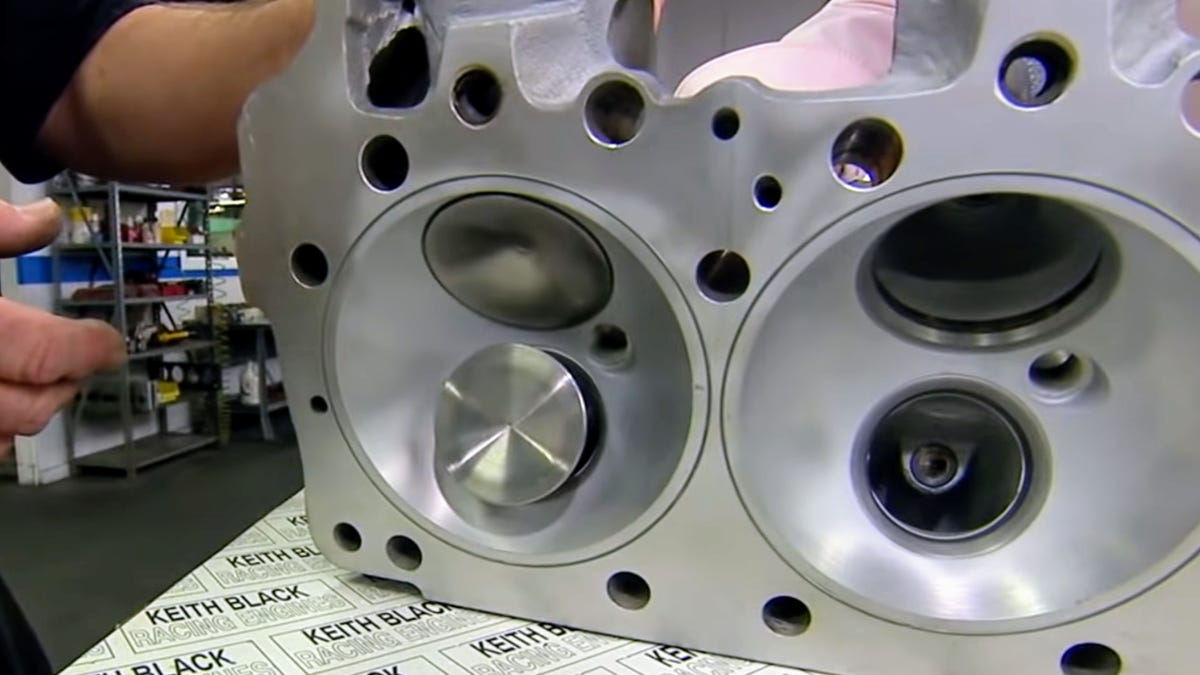Variable valve tech and what it does in your car
Carmakers spend a ton of money on technologies like VTEC. Here's why.

The big valves featured on a true hemi head, as seen on the bench at Keith Black Racing Engines.
When you check out the features of a new car, you'll probably be bombarded with glowing words about its engine's "advanced valvetrain technology." How did this happen? They don't shower us with details of how viruses work when they sell us cold medicine. Here's a quick explainer of what car engine valves do and why carmakers spend so much time telling you how great theirs are.
What valves do
The valves are installed in a part of the engine called the head and are responsible for letting air and/or fuel into the cylinders to be combusted -- those are called intake valves -- and for letting the exhaust from that combustion out of the cylinders -- those are called exhaust valves.
Highlighted are the valves of an engine, positioned in the head (invisible here), directly above the cylinders.
That may sound like a couple of horns in an orchestra, but valves are actually central to the nature of an engine's power, economy and emissions.
How valves work
Engine valves are operated by the rotation of a camshaft that has eccentric, egg-shaped lobes on it. As those cam lobes rotate, the high part of their egg shape presses on the valve, moving it into an open position.
Camshafts come in many sizes and applications, but all have a series of eccentric, or egg-shaped, cams machined into them.
As that cam lobe continues to rotate, its high part moves away from the valve and a spring returns the valve to its shut position.
There are three main parameters that determine the nature of that open-and-shut dance: timing, lift and duration. (This is where you really need to watch the video near the top of this page!)
Timing
Like anything that rotates, a camshaft turns 360 degrees as it works. Where in that 360 degrees the peak of the egg-shaped lobe is pointed is the valve timing -- the timing of when the cam lobe presses on the valve during the shaft's rotation.
Where in 360 degrees of the camshaft this lobe points determines its timing.
It's called timing because it determines when the valve opens in relation to what's happening in the rest of the engine at a given time, since everything in an engine is locked together mechanically.
Lift
The height of the the cam lobe, or how tall its egg-shaped point is, determines lift. The taller that end, the farther it will move or "lift" the valve. That amount of lift largely determines how big of an opening is created in the cylinder to get air or fuel in or to get exhaust out.
Duration
The width or breadth of the cam lobe determines the duration, or how long it performs lift on the valve. This determines how much time a cylinder has to breath in or out.
The width, or breadth, of the "shoulders" on either side of this cam lobe's peak determines its duration.
A narrow, peaky cam lobe opens a valve briefly, where a wider, broader cam lobe spends more time keeping the valve open as the camshaft rotates.
Making all that variable
As you can tell, the egg-shaped cam lobes are deceptively complicated and contain a lot of "commands" in their organic shape. But even those nuanced factors aren't enough for modern engines; in the last few decades, carmakers have made tIming, lift and duration variable as the engine runs.
Variable timing
Ideally, cam lobes press on the valves at times that vary with engine rpm and load, something hard to imagine in a fixed, machined camshaft shape. But Porsche's VarioCam tech was one of the first examples to do exactly that by varying the relationship between the camshaft and the gear that turns it.
Specifically, that allowed Porsche to alters the intake valves' timing relative to the position of the pistons in the cylinder as well as the timing of the exhaust valves. It's fuzzy, but above is a factory visual of how VarioCam changes intake valve timing. Most modern gas-engined cars now use some technique to vary their valve timing.
Variable lift
Honda's famed VTEC engines put variable valve lift on the mainstream map. Using a mechanical linkage, VTEC engines can choose between two differently shaped camshaft lobes to each operate a given valve: One opens the valve a lot, the other one opens the valve less. The choice of which lobes to use at a given moment is made by the engine computer as it monitors engine rpm and load.
That VTEC shift from a less-opening cam lobe to a more-opening one spawned one of the most widespread memes in all of autodom.
Variable duration
The duration that a cam lobe acts on a valve was perhaps the hardest factor to make variable, but Hyundai's new CVVD technology recently did it. It varies duration by slightly sliding the camshaft sideways off its rotational centerline as it turns. It's an unbearably complicated mechanism, but that's part of why it arrived decades after the previous two variable technologies. It should arrive in some new Hyundais in late 2020.
The future
All of this is pretty impressive tech but, frankly, it's just a complicated set of Band-Aids for a century-old automotive technology: camshaft-actuated valves. In the future, we might dispense with the entire Rube Goldberg apparatus and drive cars with dIrect, camless valve actuation, an emerging technology that uses a simple solenoid or electric motor to operate each valve.
Or you'll just drive an EV and forget about all this nonsense.

